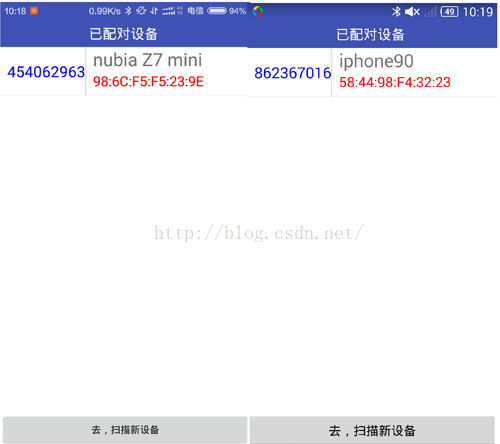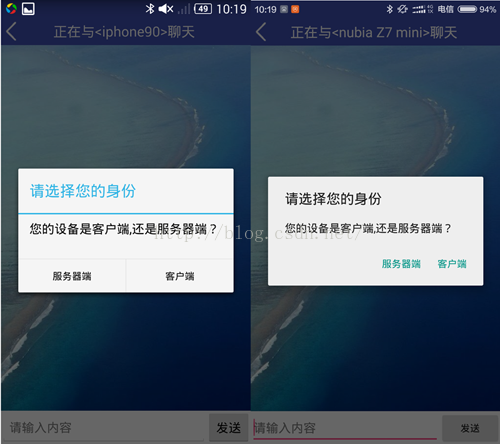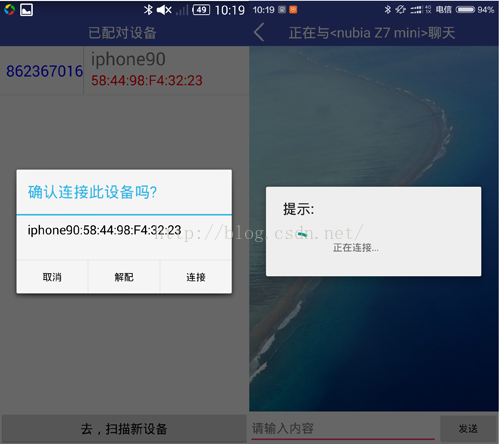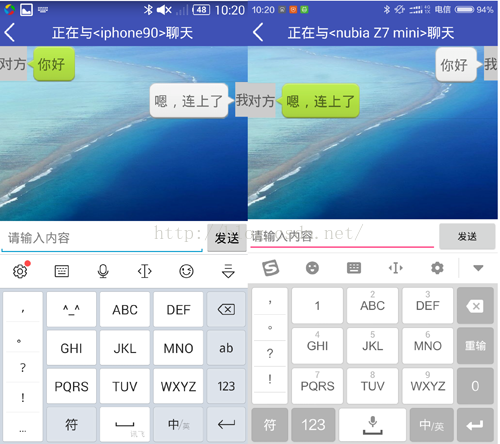編輯:關於Android編程
想使用藍牙呢,首先得看手機是否支持,有些低配手機,可能就沒有內置藍牙模塊。當然,一般都會有,我們可以得到唯一的藍牙適配器,進行其他操作。
bluetoothAdapter = BluetoothAdapter.getDefaultAdapter();
/**
* 開啟藍牙
*
* @param activity 上下文
* @return 是否開啟成功
*/
public static boolean openBluetooth(Activity activity) {
//確認開啟藍牙
if (!getInstance().isEnabled()) {
//=默認120秒==============================================================
//使藍牙設備可見,方便配對
//Intent in = new Intent(BluetoothAdapter.ACTION_REQUEST_DISCOVERABLE);
//in.putExtra(BluetoothAdapter.EXTRA_DISCOVERABLE_DURATION, 300);
//activity.startActivityForResult(in,Activity.RESULT_OK);
//=1=============================================================
//請求用戶開啟,需要提示
//Intent intent = new Intent(BluetoothAdapter.ACTION_REQUEST_ENABLE);
//startActivityForResult(intent, RESULT_FIRST_USER);
//=2=============================================================
//程序直接開啟,不經過提示
getInstance().enable();
}
//T.showLong(context, "已經開啟藍牙");
return getInstance().isEnabled();
}
//關閉藍牙
public static boolean closeBluetooth() {
return getInstance().disable();
}
/**
* 掃描已經配對的設備
*
* @return
*/
public static ArrayList scanPairs() {
ArrayList list = null;
Set deviceSet = getInstance().getBondedDevices();
if (deviceSet.size() > 0) {
//存在已經配對過的藍牙設備
list = new ArrayList<>();
list.addAll(deviceSet);
}
return list;
}
//開始掃描
public static void scan() {
getInstance().startDiscovery();
}
//取消掃描
public static void cancelScan() {
if (getInstance().isDiscovering())
getInstance().cancelDiscovery();
}
//藍牙配對
@TargetApi(Build.VERSION_CODES.KITKAT)
public static boolean createBond(BluetoothDevice device) {
return bond(device, "createBond");
/*if (device.createBond()) {
return device.setPairingConfirmation(true);
}
return false;*/
}
//解除配對
public static boolean removeBond(BluetoothDevice device) {
return bond(device, "removeBond");
}
@TargetApi(Build.VERSION_CODES.KITKAT)
private static boolean bond(BluetoothDevice device, String methodName) {
Boolean returnValue = false;
if (device != null && device.getBondState() == BluetoothDevice.BOND_NONE) {
try {
device.setPairingConfirmation(false);
cancelPairingUserInput(device);
Method removeBondMethod = BluetoothDevice.class.getMethod(methodName);
returnValue = (Boolean) removeBondMethod.invoke(device);
} catch (Exception e) {
e.printStackTrace();
}
}
return returnValue;
}
//取消配對
public static boolean cancelBondProcess(BluetoothDevice device) {
try {
Method cancelBondMethod = BluetoothDevice.class.getMethod("cancelBondProcess");
Boolean returnValue = (Boolean) cancelBondMethod.invoke(device);
return returnValue.booleanValue();
} catch (Exception e) {
e.printStackTrace();
}
return false;
}
//取消用戶輸入
public static boolean cancelPairingUserInput(BluetoothDevice device) {
try {
Method cancelPairingUserInputMethod = BluetoothDevice.class.getMethod("cancelPairingUserInput");
Boolean returnValue = (Boolean) cancelPairingUserInputMethod.invoke(device);
return returnValue.booleanValue();
} catch (Exception e) {
e.printStackTrace();
}
return false;
}
//注冊藍牙接收廣播
if (!hasRegister) {
hasRegister = true;
//掃描結束廣播
IntentFilter filter = new IntentFilter(BluetoothAdapter.ACTION_DISCOVERY_FINISHED);
//找到設備廣播
filter.addAction(BluetoothDevice.ACTION_FOUND);
filter.addAction(BluetoothDevice.ACTION_BOND_STATE_CHANGED);
filter.addAction(BluetoothAdapter.ACTION_SCAN_MODE_CHANGED);
filter.addAction(BluetoothAdapter.ACTION_STATE_CHANGED);
filter.addAction(BluetoothDevice.ACTION_PAIRING_REQUEST);
registerReceiver(mMyReceiver, filter);
}
private class MyReceiver extends BroadcastReceiver {
@Override
public void onReceive(Context context, Intent intent) {
String action = intent.getAction();
if (BluetoothDevice.ACTION_FOUND.equals(action)) {
//搜索到新設備
BluetoothDevice device = intent.getParcelableExtra(BluetoothDevice.EXTRA_DEVICE);
//搜索沒有配過對的藍牙設備
if (device.getBondState() != BluetoothDevice.BOND_BONDED) {
mListData.add(device);
dataAdapter.refreshData(mListData);
} else {
T.showLong(TwoActivity.this, device.getName() + '\n' + device.getAddress() + " > 已發現");
}
} else if (BluetoothAdapter.ACTION_DISCOVERY_FINISHED.equals(action)) { //搜索結束
if (mListData.size() == 0) {
T.showLong(TwoActivity.this, "沒有發現任何藍牙設備");
}
progressDialog.dismiss();
scan.setText("重新掃描");
} else if (BluetoothDevice.ACTION_PAIRING_REQUEST.equals(action)) {
if (TwoActivity.this.position != -1) {
final BluetoothDevice device = mListData.get(TwoActivity.this.position);
com.dk.bluetooth.tools.T.showLong(TwoActivity.this, device + " 配對成功");
EventBus.getDefault().post(new com.dk.bluetooth.tools.MyEvent());
}
}
}
}
通訊需要建立信道,BluetoothServerSocket需要先啟動,監聽當前設備上的某UUID位置上的設備(阻塞到在此處),就跟windows的端口意思是一樣的。然後BluetoothSocket再啟動,根據對方的mac地址和對方監聽的UUID位置,啟動連接(也阻塞了),直到連上服務器了,就返回。服務器也一樣,直到有人來連接了,就返回。都會返回一個BluetoothSocket,然後從這個socket裡面獲取input和output流。服務器端了input流是客戶端的output流,另外一半也一樣。剩下的收發消息就是流的讀寫了,簡單吧。
下面貼出我的代碼,應為服務器端和客戶端啟動的方法不一樣,我分成了兩個線程,由於讀寫的功能一樣,我就共用了一套讀寫線程。根據這個思路看我的代碼。
/**
* 初始化及啟動藍牙socket
*
* @param handler UI消息傳遞對象
* @param securityType 連接的安全模式
* @param serverOrClient 客戶端或服務端
* @param bluetoothDevice 服務器端設備
*/
public BluetoothChatService(Handler handler, SecurityType securityType, ServerOrClient serverOrClient,
BluetoothDevice bluetoothDevice) {
if (securityType != null)
this.mSecurityType = securityType;
if (serverOrClient != null)
this.mServerOrClient = serverOrClient;
if (bluetoothDevice != null)
this.mBluetoothDevice = bluetoothDevice;
mAdapter = BluetoothAdapter.getDefaultAdapter();
mHandler = handler;
start();
}
/**
* 多線程同步修改狀態標識
*
* @param state
*/
private synchronized void setState(int state) {
mState = state;
mHandler.obtainMessage(MESSAGE_TOAST_STATE_CHANGE, state, -1, null).sendToTarget();
}
/**
* 多線程同步讀取狀態標識
*/
public synchronized int getState() {
return mState;
}
/**
* 啟動服務
*/
public void start() {
start(null, null, null);
}
/**
* 啟動服務
*
* @param securityType 連接的安全模式
* @param serverOrClient 客戶端或服務端
* @param bluetoothDevice 服務器端設備
*/
public void start(SecurityType securityType, ServerOrClient serverOrClient, BluetoothDevice bluetoothDevice) {
if (securityType != null)
this.mSecurityType = securityType;
if (this.mSecurityType == null) {
if (DEBUG)
Log.e(TAG, "mSecurityType cannot be null");
mHandler.obtainMessage(MESSAGE_TOAST_ERROR, -1, -1, "mSecurityType cannot be null").sendToTarget();
return;
}
if (serverOrClient != null)
this.mServerOrClient = serverOrClient;
if (this.mServerOrClient == null) {
if (DEBUG)
Log.e(TAG, "mServerOrClient cannot be null");
mHandler.obtainMessage(MESSAGE_TOAST_ERROR, -1, -1, "mServerOrClient cannot be null").sendToTarget();
return;
}
if (bluetoothDevice != null)
this.mBluetoothDevice = bluetoothDevice;
if (this.mBluetoothDevice == null) {
if (DEBUG)
Log.e(TAG, "mBluetoothDevice cannot be null");
mHandler.obtainMessage(MESSAGE_TOAST_ERROR, -1, -1, "mBluetoothDevice cannot be null").sendToTarget();
return;
}
if (mState == STATE_NONE) {
stop();
if (this.mServerOrClient == ServerOrClient.SERVER) {
if (mServerConnectThread == null) {
mServerConnectThread = new ServerConnectThread(this.mSecurityType);
mServerConnectThread.start();
}
} else if (this.mServerOrClient == ServerOrClient.CLIENT) {
if (mClientConnectThread == null) {
mClientConnectThread = new ClientConnectThread(this.mSecurityType);
mClientConnectThread.start();
}
}
setState(STATE_LISTEN);
}
}
/**
* 停止服務
*/
public synchronized void stop() {
try {
if (mReadWriteThread != null) {
mReadWriteThread.cancel();
mReadWriteThread = null;
}
if (mServerConnectThread != null) {
mServerConnectThread.cancel();
mServerConnectThread = null;
}
if (mClientConnectThread != null) {
mClientConnectThread.cancel();
mClientConnectThread = null;
}
} catch (Exception e) {
e.printStackTrace();
if (DEBUG)
Log.e(TAG, "BluetoothChatService -> stop() -> :failed " + e.getMessage());
mHandler.obtainMessage(MESSAGE_TOAST_ERROR, -1, -1, "BluetoothChatService -> stop() -> :failed").sendToTarget();
mReadWriteThread = null;
mServerConnectThread = null;
mClientConnectThread = null;
} finally {
setState(STATE_NONE);
System.gc();
}
}
/**
* 發送消息
*
* @param out 數據參數
*/
public void write(String out) {
if (TextUtils.isEmpty(out)) {
if (DEBUG)
Log.e(TAG, "please write something now");
mHandler.obtainMessage(MESSAGE_TOAST_ERROR, -1, -1, "BluetoothChatService -> write() -> :failed").sendToTarget();
return;
}
ReadWriteThread r;
synchronized (this) {
if (mState != STATE_CONNECTED)
return;
r = mReadWriteThread;
}
r.write(out);
}
/**
* 服務器端連接線程
*/
@SuppressLint("NewApi")
private class ServerConnectThread extends Thread {
private BluetoothServerSocket mmServerSocket;
private BluetoothSocket mmSocket = null;
public ServerConnectThread(SecurityType securityType) {
setName("ServerConnectionThread:" + securityType.getValue());
BluetoothServerSocket tmp = null;
try {
if (securityType == SecurityType.SECURE) {
tmp = mAdapter.listenUsingRfcommWithServiceRecord(SecurityType.SECURE.getValue(), MY_UUID_SECURE);
} else if (securityType == SecurityType.INSECURE) {
tmp = mAdapter.listenUsingInsecureRfcommWithServiceRecord(SecurityType.INSECURE.getValue(),
MY_UUID_INSECURE);
}
if (tmp != null)
mmServerSocket = tmp;
} catch (IOException e) {
e.printStackTrace();
if (DEBUG)
Log.e(TAG, "ServerConnectThread -> ServerConnectThread() -> :failed " + e.getMessage());
mHandler.obtainMessage(MESSAGE_TOAST_ERROR, -1, -1, "ServerConnectThread -> ServerConnectThread() -> :failed").sendToTarget();
mmServerSocket = null;
BluetoothChatService.this.stop();
}
}
public void run() {
try {
// 正在連接
setState(STATE_CONNECTING);
//accept() 阻塞式的方法,群聊時,需要循環accept接收客戶端
mmSocket = mmServerSocket.accept();
connected(mmSocket);
} catch (Exception e) {
e.printStackTrace();
if (DEBUG)
Log.e(TAG, "ServerConnectThread -> run() -> :failed " + e.getMessage());
mHandler.obtainMessage(MESSAGE_TOAST_ERROR, -1, -1, "ServerConnectThread -> run() -> :failed").sendToTarget();
BluetoothChatService.this.stop();
}
}
public void cancel() {
try {
if (mmSocket != null) {
mmSocket.close();
mmSocket = null;
}
if (mmServerSocket != null) {
mmServerSocket.close();
mmServerSocket = null;
}
} catch (IOException e) {
e.printStackTrace();
if (DEBUG)
Log.e(TAG, "ServerConnectThread -> cancel() -> :failed " + e.getMessage());
mHandler.obtainMessage(MESSAGE_TOAST_ERROR, -1, -1, "ServerConnectThread -> cancel() -> :failed").sendToTarget();
mmSocket = null;
mmServerSocket = null;
BluetoothChatService.this.stop();
}
}
}
// 客戶端連接線程
private class ClientConnectThread extends Thread {
private BluetoothSocket mmSocket;
public ClientConnectThread(SecurityType securityType) {
setName("ClientConnectThread:" + securityType.getValue());
BluetoothSocket tmp = null;
try {
if (securityType == SecurityType.SECURE) {
tmp = mBluetoothDevice.createRfcommSocketToServiceRecord(MY_UUID_SECURE);
//Method m = mBluetoothDevice.getClass().getMethod("createRfcommSocket", int.class);
//tmp = (BluetoothSocket) m.invoke(mBluetoothDevice, 1);
} else if (securityType == SecurityType.INSECURE) {
tmp = mBluetoothDevice.createInsecureRfcommSocketToServiceRecord(MY_UUID_INSECURE);
//Method m = mBluetoothDevice.getClass().getMethod("createRfcommSocket", int.class);
//tmp = (BluetoothSocket) m.invoke(mBluetoothDevice, 1);
}
if (tmp != null)
mmSocket = tmp;
} catch (Exception e) {
e.printStackTrace();
if (DEBUG)
Log.e(TAG, "ClientConnectThread -> ClientConnectThread() -> :failed " + e.getMessage());
mHandler.obtainMessage(MESSAGE_TOAST_ERROR, -1, -1, "ClientConnectThread -> ClientConnectThread() -> :failed").sendToTarget();
mmSocket = null;
BluetoothChatService.this.stop();
}
}
public void run() {
try {
setState(STATE_CONNECTING);
mmSocket.connect();
connected(mmSocket);
} catch (IOException e) {
e.printStackTrace();
if (DEBUG)
Log.e(TAG, "ClientConnectThread -> run() -> :failed " + e.getMessage());
mHandler.obtainMessage(MESSAGE_TOAST_ERROR, -1, -1, "ClientConnectThread -> run() -> :failed").sendToTarget();
BluetoothChatService.this.stop();
}
}
public void cancel() {
try {
if (mmSocket != null && mmSocket.isConnected()) {
mmSocket.close();
}
mmSocket = null;
} catch (IOException e) {
e.printStackTrace();
if (DEBUG)
Log.e(TAG, "ClientConnectThread -> cancel() -> :failed " + e.getMessage());
mHandler.obtainMessage(MESSAGE_TOAST_ERROR, -1, -1, "ClientConnectThread -> cancel() -> :failed").sendToTarget();
mmSocket = null;
BluetoothChatService.this.stop();
}
}
}
/**
* 以獲取socket,建立數據流線程
*
* @param socket
*/
private synchronized void connected(BluetoothSocket socket) {
if (mReadWriteThread != null) {
mReadWriteThread.cancel();
mReadWriteThread = null;
}
mReadWriteThread = new ReadWriteThread(socket);
mReadWriteThread.start();
}
/**
* 連接成功線程,可進行讀寫操作
*/
private class ReadWriteThread extends Thread {
private BluetoothSocket mmSocket;
private DataInputStream mmInStream;
private DataOutputStream mmOutStream;
private boolean isRunning = true;
public ReadWriteThread(BluetoothSocket socket) {
mmSocket = socket;
try {
mmInStream = new DataInputStream(mmSocket.getInputStream());
mmOutStream = new DataOutputStream(mmSocket.getOutputStream());
// 連接建立成功
setState(STATE_CONNECTED);
} catch (IOException e) {
e.printStackTrace();
if (DEBUG)
Log.e(TAG, "ReadWriteThread -> ReadWriteThread() -> :failed " + e.getMessage());
mHandler.obtainMessage(MESSAGE_TOAST_ERROR, -1, -1, "ReadWriteThread -> ReadWriteThread() -> :failed").sendToTarget();
mmOutStream = null;
mmInStream = null;
BluetoothChatService.this.stop();
}
}
public void run() {
byte[] buffer = new byte[1024];
int len;
while (isRunning) {
try {
//readUTF(),read(buffer) 都是阻塞式的方法
//如果這兒用readUTF,那麼寫的地方得用writeUTF。對應
String receive_str = mmInStream.readUTF();
if (!TextUtils.isEmpty(receive_str))
mHandler.obtainMessage(MESSAGE_RECEIVE, -1, -1, receive_str).sendToTarget();
// len = mmInStream.read(buffer);
// if(len > 0){
// String receive_str = new String(buffer,0,len);
// if (!TextUtils.isEmpty(receive_str))
// mHandler.obtainMessage(MESSAGE_RECEIVE, -1, -1, receive_str).sendToTarget();
// }
} catch (IOException e) {
e.printStackTrace();
if (DEBUG)
Log.e(TAG, "ReadWriteThread -> run() -> :failed " + e.getMessage());
mHandler.obtainMessage(MESSAGE_TOAST_ERROR, -1, -1, "ReadWriteThread -> run() -> :failed").sendToTarget();
BluetoothChatService.this.stop();
}
}
}
public void write(String str) {
try {
mmOutStream.writeUTF(str);
mmOutStream.flush();
mHandler.obtainMessage(MESSAGE_TOAST_SEND, -1, -1, str).sendToTarget();
} catch (IOException e) {
e.printStackTrace();
if (DEBUG)
Log.e(TAG, "ReadWriteThread -> write() -> :failed " + e.getMessage());
mHandler.obtainMessage(MESSAGE_TOAST_ERROR, -1, -1, "ReadWriteThread -> write() -> :failed").sendToTarget();
BluetoothChatService.this.stop();
}
}
public void cancel() {
try {
isRunning = false;
if (mmInStream != null) {
mmInStream.close();
mmInStream = null;
}
if (mmOutStream != null) {
mmOutStream.close();
mmOutStream = null;
}
} catch (IOException e) {
e.printStackTrace();
if (DEBUG)
Log.e(TAG, "ReadWriteThread -> cancel() -> :failed " + e.getMessage());
mHandler.obtainMessage(MESSAGE_TOAST_ERROR, -1, -1, "ReadWriteThread -> cancel() -> :failed").sendToTarget();
mmInStream = null;
mmOutStream = null;
BluetoothChatService.this.stop();
}
}
}
下面貼出我的項目功能,是一個聊天程序,只能單聊。我不明太網上有很多demo聲稱能群聊怎麼實現的,據目前分析,服務器端和客戶端的管道流是一一對應的,不是廣播模式。如果能群聊,會在服務器端創建一個輸入輸出流管理的集合吧,服務器端沒收到一條消息,在=再循環輸出流集合,往各個客戶端都發送消息。這樣一來,我上面的這段代碼不夠用了。懶得改,故沒有做群聊。
先貼圖:




程序中,socket的連接方式有安全連接和不安全連接,我一直沒有搞懂區別
在兩個手機都連接了wifi的情況加,再使用我這種藍牙通訊方式通訊時,io流連接上後會自動斷開,很奇怪。查資料說藍牙通訊的波段頻率與路由器的沖突了。沒轍,故在啟動程序的時候關閉了wifi,下下策,望大家提供思路。
 Android仿微信清理內存圖表動畫(解決surfaceView屏幕閃爍問題)demo實例詳解
Android仿微信清理內存圖表動畫(解決surfaceView屏幕閃爍問題)demo實例詳解
最近接了一個項目其中有功能要實現一個清理內存,要求和微信的效果一樣。於是想到用surfaceView而不是繼承view。下面小編給大家解析下實現思路。surfaceVie
 android數據傳遞(三)之Activity傳遞到Fragment
android數據傳遞(三)之Activity傳遞到Fragment
其實Activity和fragment之間傳遞數據有很多方法,我這裡說一個用的比較多的一個方法——接口回調,後面有運行效果接口回調有幾個步驟:1,
 局部加權回歸、欠擬合、過擬合 - Andrew Ng機器學習公開課筆記1.3
局部加權回歸、欠擬合、過擬合 - Andrew Ng機器學習公開課筆記1.3
本文主要講解局部加權(線性)回歸。在講解局部加權線性回歸之前,先講解兩個概念:欠擬合、過擬合,由此引出局部加權線性回歸算法。 欠擬合、過擬合如下圖中三個擬合模型
 Android動畫完全解析(一)
Android動畫完全解析(一)
一、View動畫1、常見的4中View動畫:AlphaAnimation、ScaleAnimation、TranslateAnimation、RotateAnimatio